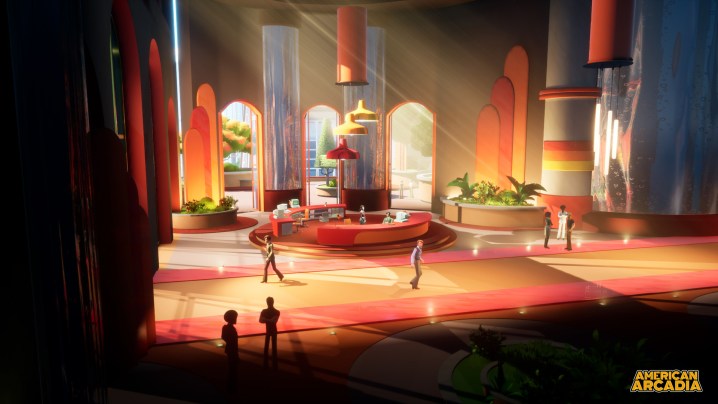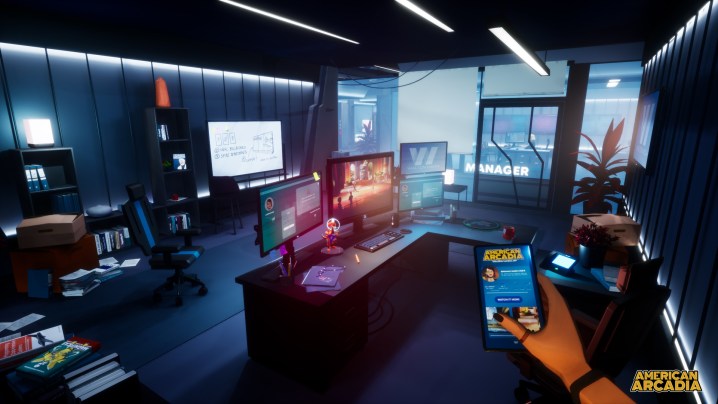
The 2D platformer and first-person puzzler genres are both pretty played out. From Super Mario Bros. 3 for platformers to Portal for first-person puzzle games, it’s unlikely that there are many surprises left in each genre individually. So why not mash them together as American Arcadia does?
The next game from Spanish developer Out of the Blue and publisher Raw Fury is about a typically unsuspecting worker attempting to escape from Arcadia. That place seems to be a capitalist utopia but is actually a demented The Truman Show-like reality show where unpopular characters or those who find out too much die. American Arcadia’s compelling story and genre mashup left the biggest impression on me out of anything at this year’s Tribeca Fest.
Inside Arcadia
My demo started with Trevor, a lanky and nerdy worker, being interrogated over his attempts to flee from Arcadia. This immediately sets up an air of intrigue and gave the demo (and presumably the full game) a clever framing device. I then saw how this whole fiasco started. Trevor works for megacorp INAC as a lowly office worker helping to run a supercomputer called Ada.
Trevor comes into work one day to discover that his friend Gus won an all-expenses-paid trip to another country, but as he’s working, the devices around him are hacked, and a mysterious benefactor tells him that Gus is dead and that he’ll die soon too if he doesn’t run. Obviously, this scares Trevor, who follows this mysterious guardian angel’s instructions to a back room to find that there isn’t a supercomputer there, but a performance stage instead.
When playing as Trevor, American Arcadia plays out as a simple 2D cinematic puzzle-platformer. He has a weighty jump and usually needs to push or pull objects into place to help him climb high enough or jump far enough to progress. Those who’ve played games like Inside before know the deal.
Soon into his escape, we learn that the person helping him is named Angela and that she can help him by hacking into cameras to alter the environment and help Trevor move forward. For example, she can move a light backstage so Trevor can see where he’s going. This first gameplay twist reminds me of Republique, a game I adore that’s also about helping someone break free from an overbearing capitalist totalitarian society.

While Republique was a third-person stealth game, the formula works just as well with a 2D cinematic platformer, and is one’s first indication that this game is far from simple. I didn’t have to wait long for the next wild gameplay twist to emerge either. While Angela had hacked Trevor’s card to get him access to areas he shouldn’t be in, it stops working, and guards working for INAC become aware of his impending escape.
A shift in perspective
Until this point, the American Arcadia has just been a platformer, but when Trevor is about to get caught, Angela gets out of her seat to override the server room herself. This is when American Arcadia shockingly becomes a first-person puzzle game. The wide, cinematic shots and camera gameplay elements of the platforming segments already made me feel like an observer of Trevor’s bad day, and this Angela segment helped cement that feeling.
The shift in perspective really puts me in stage technician Angela’s shoes as she frantically tries to help Trevor. The puzzles in the section weren’t very hard. I simply had to walk up to three cameras and loop their camera footage and then input a code I could see through a window. Still, the bones of an excellent first-person puzzler are here.
Developer Out of the Blue’s previous game, Call of the Sea, is one of the most underrated puzzle games of the past couple of years. As such, the developers have room to build on an already solid puzzle game base and make the puzzles more complex and satisfying to solve. Angela’s efforts ultimately allow Trevor to get to the roof of the INAC building, but he’s still being pursued.

The demo’s final chase was particularly memorable as I had to use my camera to override powers to swing a crane around, climb on it, and swing it back around so Trevor could escape his pursuers. My demo concluded mid-jump as Trevor tried leaping to a pool. While Trevor obviously survives that jump, it did leave me wanting more so I can see the rest of Angela and Trevor’s doomed escape and how he’s eventually captured (at least temporarily).
I’m also excited to see how Out of the Blue expands upon the first-person puzzle segments as Angela and just how often they’ll intersect with Trevor’s platforming. We’ve seen cinematic 2D platformers and first-person puzzle games both executed well individually before. But by melding the two genres, Out of the Blue is crafting a unique adventure that’s not quite like any other game out there. If the story holds up, American Arcadia will be quite the indie darling when it launches.
American Arcadia is in development for PC and consoles.



